Akademos
Revealing and Writing the Living Soil
post(s)
Universidad San Francisco de Quito USFQ, Ecuador
ISSN: 1390-9797
ISSN-e: 2631-2670
vol. 8, no. 1, 2022
Received: 20 April 2022
Accepted: 25 May 2022
Abstract: Can the soil speak? In an attempt to respond to this question, this article discusses a political and practical horizon that intends to transform relationships within the living soil. It presents a renewed method for photographing the soil: chromatography. Besides producing detailed descriptions of our own chromatograms, we also venture into an aesthetic reading of them. The result is a series of poems that might make explicit another layer of the voice of the soil.
Keywords: soil, chromatography, poetry, agriculture.
Resumen: ¿Puede hablar el suelo? Para tratar de responder a esta pregunta, este artículo aborda un horizonte político y práctico que pretende transformar las relaciones dentro del suelo vivo. Presenta un método renovado para fotografiar el suelo: la cromatografía. Además de producir descripciones detalladas de nuestros propios cromatogramas, también nos aventuramos en una lectura estética de los mismos. El resultado es una serie de poemas que podrían hacer explícito otro estrato de la voz del suelo.
Palabras clave: suelo, cromatografía, poesía, agricultura.
From agriculture to identity theory, the concept of origin shapes the validity of an output. If a wine reflects the characteristics of the place it came from, then it is a good wine. If a given tree, plant, or vegetable is held to have seamlessly meshed with the ecology of the place it is being cultivated from long ago, then it is a good tree, plant, or vegetable. An ethnological study is a good study if it pays tribute to the specificity of the place where the study conducts its fieldwork. Any theory is considered authentic if it acknowledges and carefully threads the history and origin behind its concepts. And it is not only a matter of authenticity—which for the most part is a matter of inverted domination—but of preservation. Placing the origin at the horizon of any enterprise means that preserving what we have come to learn has been positive from a thick and complex experience. Interpreted at the present, the origin contains, retroactively, all the elements of a process of development or history.
This process is kept linguistically—either written down in some form of documentation or verbally kept within a community. The sciences and their method, however, since their inception have dominated the written form in matters of knowledge. More precisely, they have exercised their dominion depending closely on observation and measurement (or classification), which is a procedure that has intelligence as its referential tool. Intelligence, says Henri Bergson (1944, p. 178), thinks inert matter; but in order to think life, other tools are called for. Their value has been undeniable across all disciplines, but as we approach the limits of their methodology (for solving matters of ecology, inequality, justice, etc.) and their complicity with late settler liberalism, we find ourselves compelled to counter its advance with other approaches or methods.
In matters of agriculture, for example, soil analysis has been governed by two methods: first, by a physical method of classifying soils based on the predominant particle sizes and properties, or its location (or horizon) across the pedosphere; second, a chemical method that has claimed to have understood the composition and health of the soil and, hence, has been able to diagnose the lacking or excessive quantities of particular chemical elements or compounds within any soil sample. Irrespective of the origin of the soil, this method assumes that the soil is moldable to the purposes of the cultivator. More often than not, chemical engineers that do this type of analysis are tied to the very same business that would later sell the chemical products recommended by the analysis. Agribusiness is an ecology that has managed to converge capitalism’s need to make commodities circulate and the interests of hegemonic scientific methods of analysis. This also holds for the medical industry, the food industry, the education industry, and others.
Collaboration between the economico-political order and knowledge seems to have reached its limit and thus calls for its interruption. Firstly, we must examine the context of inequality. People who are at the bottom of the social scale are “obliged” to pay royalties for technological products while also dealing with material necessities for sustenance and survival. Knowledge is sold at a premium—the cultivator is a layman—and, more often than not, its yield and market value do not compensate for its price. In other words, knowledge here is at the service of deepening the class breach instead of liberating and making available a better quality of life. Secondly, we must consider the context of lack of evidence that the submission of knowledge to business is beneficial. In our example of agriculture, it is clear that the quality of the products of agribusiness has not lived up to health and nutrition standards (Barnett et al., 2022; Chan et al., 2013; Davis, 2009; Fan et al., 2008; Handal et al., 2008; Paz y Miño et al., 2002; Suarez-Lopez et al., 2012, 2013). Hence, agroecology and organic farming have been a thriving (and struggling) field within the possible modes of cultivation.
Thirdly, and most importantly, this collaboration has helped deepen the ontological gap between the living and the inert. For the sciences and the market, the soil and any other object that is not indicative of living is an object that can be looked at separately in a vacuum, deprived of its complex network from which it was taken apart and without recourse to any sort of historicity or memory. The people and other living organisms that coexist with these objects and that are the repository of the memory of the place are stripped of the analysis. This is a differentiation that is made available by a deeper structure that considers the inert as separate from the living. It is because the inert behaves with immediate indifference that the living organisms are further given a privileged status over the inert. With it, notwithstanding, the complexity of the world or any other given context of analysis has been severed. The inert needs to be part of the living—it needs to be considered living—if we are to advance towards a world that offers a different possibility of development, different from the ring between science and market.
Complexity is unfathomable. From this perspective, any attempt to analyze it turns out useless. We should tackle complexity with complexity. Instead of trying to break down (analyze) complexity, we should look at it from afar and treat it as an unknowledgeable unit (a monad) that may be countered with other units of the same type. The soil is certainly a complex object (it is common knowledge that a single teaspoon or 1 gram of rich garden soil can hold up to one billion (10.) bacteria, several yards of fungal filaments, several thousand protozoa, and scores of nematodes (Raynaud & Nunan, 2014)) and, as such, no chemical or disciplinary approach could ever arrive at a reliable diagnosis for all types of soil spread around the Earth. A piece of land, with its particular history and modifying environment, is complex enough to frustrate any pretensions of a laboratory analysis with claims of universality. Only an approach that lays no claim of knowledge—hence, of domination—and pays due respect to the historicity of the piece of land could humbly stand a chance in this context of complexity. The question of the origin and its preserving quality is here rendered explicit.
In attempting to dilute this problem, we propose a theoretical, political, and practical horizon that intends to transform relationships within the living soil. More concretely, we present a renewed method for photographing the soil that has lately been used by radical Latin American agronomists with two main purposes: 1. to reconceive soil analysis by prioritizing relationships within the soil dimensions (organic matter, microorganisms, and minerals); and 2. to seek independence from the domination of agribusiness. This renewed method is soil chromatography. Finally, besides producing our own chromatograms from soil with which we have been working closely and presenting detailed descriptions, we also venture into a freer and more aesthetic reading of the chromas. The result is a series of poems that might make explicit another layer of the voice of the soil and that will hopefully bring to closure the broader topic of the origin.
About chromatography
Chromatography in a few words: a map of the living soil. A map towards the health of a soil. In not so few words, a chroma is a crosscut photograph of the state of the soil at the time of a sampling. It is, first and foremost, an aesthetic analysis that requires an interpretation, one that connects the image (made up of colors, shapes, and patterns) with 1. the context and history of the soil, 2. those who have worked on and with (sometimes against) the soil, and 3. the individual carrying out the sample collection and the chroma production.
Soil chromatography is also a cross-sectional, intuitive, qualitative, ontological, and even poetic study of the here and now of the life of the soil. It was invented by the Russian botanist Mikhail Tsvet (1872-1919) and later perfected within the studies and practice of biodynamic agriculture, more specifically by Rudolf Steiner and Ehrenfried Pfeiffer. Soil chromatography was later maintained by a couple in the Netherlands (Adri and Jaap Bakker), and in the late 1990’s, Jairo Restrepo and Sebastiao Pinhero (2015) learned from them and saw the potential of using the technique as an available method for soil analysis for the campesinos of the world, with an explicit intention to fight the global takeover of agriculture and food production from corporate and industrial capital. In that sense, the present-day method and use of the technique is strongly based on Latin American radical agroecologists, and now we can see countless examples of people in Europe and some in North America translating the work from Spanish and picking up the trail. Our aspiration, by sharing this method in English, is to also contribute to this expansion to the Anglo world and to critical soil geography.
We performed the first chromas with soil samples collected in October 2020. Our learning method was a process of trial and error and learning by doing. Below we will go into more detail of the method, the process, and the reading of a chroma, with the interpretation that is made when trying to learn from it to understand soil dynamics and use the lessons for practical purposes on the field. By the end, we also extend the project to the field of poetry and attempt a poetic reading of soil chromatography. Without planning for it, chromatography resulted in being a perfect example to apply the theoretical and methodological tools we have exposed here: an intuitive and aesthetic approach to understand how life interacts within the soil in the creation of life. The chroma is a visual representation of life in its milieu. We hope to transmit what we have learned experientially during this process. If it can be summed up in one phrase: only life can generate life for the living.
After several months of learning about and performing chromatography, we participated in a two-day workshop organized by several agroecologists in the vicinities of Otavalo, on the outskirts of the Imbabura volcano. The workshop was guided by Francisco Abad, an agronomist from Cuenca and the main chromatographer in Ecuador, who is part of the growing network of young people following in the footsteps of Jairo Restrepo and Sebastiao Pinhero in the revitalization of this very old technique. Francisco began with the story of him learning from Jairo in a visit to his agronomy school in the University of Cuenca around 2012. Jairo entered lashing out with his characteristic bombastic style against the corruption of agribusiness brainwashing the minds of students and training them to be “agrotoxic prescribers.” His relentless critique of the industrial and corporate cooptation of universities to the detriment of the way of life of the campesino is well documented in countless seminars around the world and is available online in public platforms.
Now we will describe the soil chromatography method as it was passed to us mainly from Jairo Restrepo, in his seminars and books, as well as from Francisco Abad, through his work, seminars, and voluntary and generous assistance through the process.
The method
The method begins on the ground, sampling the soil. We always collect compound samples, that is, we always take at least three sub-samples from the area we are interested in and compound them in a single sample bag, using a zigzag or randomized pattern across the lot. We dig a “V” trench and then use a small gardening shovel or a spoon to take the sample from the desired depth. There are professional tools, such as the earth auger, for gathering soil samples at different depths.
The samples are placed in a labeled bag, mixing them thoroughly before placing them to dry in a low temperature (< 40°C) dehydrator, or in indirect sunlight. Soil is then immediately ground and sifted for storage. This whole process takes 12 to 48 hours, depending on how long it takes the collected soil to reach the dehydrator. We label everything: date, place, depth, and number of subsamples, at the very least. If the place and soil context are not familiar, then it is a good idea to annotate every observation of the collection site. However, in most places from where we collect samples, we are familiarized with the climatic context, the color, texture, and humidity of the soil, as well as the type of roots, flora, and soil macrofauna (worms and insects) we see at the desired depth.
For most horticultural soils or any sort of annual crops, we collect samples at a depth of 30 cm. For perennial crops with deeper roots, it is wise to go at least 40 or 50 cm. If we are interested in trees, either fruiting or of foresting quality, the ideal depth is at least 100 cm or even deeper. In a few cases we are interested in the entire soil profile, so we have gathered samples in the same plot at 30 cm, 50 cm, 80 cm, 170 cm, and 220 cm. In some cases, we take the opportunity when someone is digging for other purposes to collect deeper samples of a soil we are working with, or one nearby. For example, we collected samples of varying depths during the construction of a water reservoir (Fig. 1).
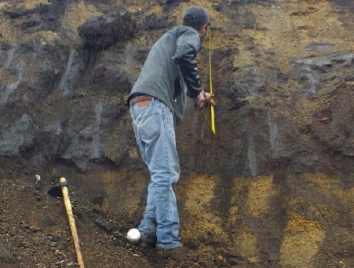
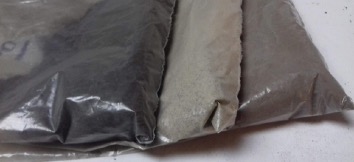
While the samples dry, we prepare a 1% solution of sodium hydroxide, NaOH. This is our solvent for the soil sample. To prepare one liter of solution, we dissolve 10 g of NaOH in one liter of distilled water. Then we prepare a dilution of 0.5% silver nitrate, AgNO3, by mixing 0.5 g of AgNO3 with 100 ml of distilled water. This is the photo-sensitive solution to impregnate the filter papers and reveal the chromatographic image of the soil. Then we need to prepare the filter paper; we use the Whatman filter paper grade No. 4 with 150 mm diameter. We find the center and punch a 2 mm hole. It is necessary to prepare a wick from another filter paper of the same quality, so we cut a 2 cm square and roll it into the hole in the middle of the filter paper. We mark spots at 4 cm and 6 cm from the center, as this will mark the limits of the impregnation of our sample. We mark the spots with a 2HB pencil, since the graphite does not interfere with the chromas. It is a material that is too heavy and does not dissolve in NaOH, so it doesn’t run on the paper. Using filter paper No. 1 of 185 mm diameter is a bit more challenging, and dilutions need to be adjusted to run samples more appropriately on this paper. After some experimentation, the most convenient paper for fast analysis is No. 4 - 150 mm, but the most beautiful and detailed chromas are revealed using paper No. 1 - 185 mm.
We now need to impregnate the filter paper with the AgNO3 to make the soil solution that will run through it photosensitive and to reveal the colors and patterns we are looking for. At this point, the room where we work is only illuminated by a red light bulb. We place a small petri dish inside a larger petri dish, and we fill the small petri with the solution of 0.5% AgNO3. We then place the filter paper on top with the wick submerged in the solution, and we let it run all the way to our first mark of 4 cm.
Once the AgNO3 solution reaches the 4 cm mark, we remove the wick and leave the papers between absorbing towels to dry in a dark box. While the impregnated papers are drying, we dilute the soil sample with the 1% NaOH solution. We mix 5 g of the prepared sample with 50 ml of the 1% NaOH solution in an Erlenmeyer flask. There are some variations to this part of the process when dealing with samples much denser in mineral content such as andosols, very common in Ecuador and usually from the páramos where, due to the high altitude, soil minerals are incredibly rich but soil metabolism is very slow. In these cases, instead of a 10% dilution, 5 g of soil in 50 ml of solution, we use a 5% dilution by mixing only 2.5 g of soil with 50 ml of the NaOH solution. In some of these samples, we have even gone to 1.25% dilution with 2.5 g of soil in 200 ml of solution. For liquid biofertilizers, or any sort of liquid samples, the process is slightly different. We will not go into details on this here, as it would not fit the purpose of this article.
Now begins the process of mixing the sample and adding the dynamization process, as this method has been developed and described to us. Moving in circular motions, we begin clockwise seven turns, then counterclockwise seven turns, and we repeat this process seven times. Then we let the solution sit for 15 minutes and we repeat the process, letting it sit for 60 minutes. After 60 minutes we repeat this process one last time and let it sit for six hours.
Once we have our dry and prepared filter papers and soil solutions, we organize the same arrangement of petri dishes and fill the small petri dish with the supernatant carefully extracted with a syringe or a pipette taken without disturbing the solution. Approximately 10 ml of supernatant is needed to fill the small petri dish. We insert another wick, place the impregnated paper with the wick submerged, and let the soil sample run all the way to the 6 cm mark on the filter paper.
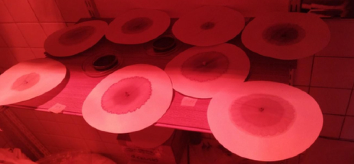
Lab work is almost the stereotype of scientific work, and we are now reminded of why that is. It is very important to keep meticulous attention to detail, constant observation, registration, and careful movements that require attention so the observations and records can be more precise. Once we felt comfortable with the tools and equipment, everything ran smoothly, and we could do over 50 samples simultaneously. We particularly enjoyed extracting the supernatant from the flasks with a pipette. By this point, the samples have been stirred 49 times in both directions and are now still for over 6 hours. The sediment is clearly visible, and the rich deep color of the liquid is seductive. It feels that we are working with something valuable, precious, profound…something pure, whatever that may mean, and definitely not in the literal meaning of the word.
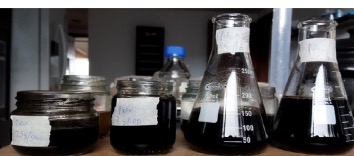
The chromas are ready and need to be left to dry and revealed by progressively exposing them to indirect light. It can take a day to dry and at least three days to fully reveal all the patterns and colors. For storing them, it is useful to submerge them in liquid paraffin wax and scan them, saving them in a folder protected from light.
Describing a chroma: Zones, colors, patterns, transitions
A chroma is comprised of five sections: 1. central zone, 2. internal zone, 3. intermediate zone, 4. external zone, and 5. peripheral zone. The reading of the chroma also takes place in five steps. It includes an analysis of the first four zones of the chroma proper (zones 1 to 4) and an integral reading of the integration or transition of all the zones. The central zone represents the most mechanical part of the soil, the structure, its aeration and water holding capacity. Zone 2 is where the heaviest molecules are found, closer to the center, composed of mostly heavier mineral components. We call this the mineral zone. Zone 3, also called the organic matter zone, is where organic molecules are found. Zone 4 is where the lightest molecules, mostly protein material, are found, farthest from the center. We call this the enzymatic zone, or metabolic zone. The periphery of the chroma is free from solution and is used for handling and labeling the chroma.
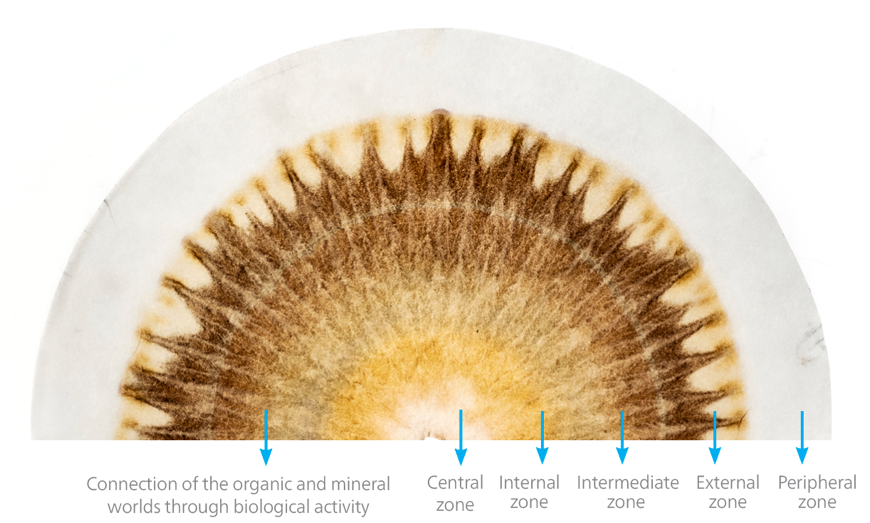
What we are looking for in the chromas are basically four aspects: size (in relation or proportion to the entirety of the chroma and to the other layers), colors, patterns, and transitions among the different zones. On size, there is not much to see, except when a zone is predominantly larger or smaller in proportion to the other zones. On the other aspects, there is not an ideal combination, but what we look for, generally speaking, is that there is a set of “desirable characteristics” and others that are “undesirable.” The key part of reading a chroma lies in an integral reading of all the zones, aspects, and characteristics as a whole. The only way to make sense of a particular chroma is if you have a context in mind, one that involves what has happened and is happening to the soil before and around the time of the collection of the sample. The key things we account for are the depth, the type of crop or covering of the soil, climatic conditions at the time of collection, and particular interventions that the soil has been exposed to. These can be the addition of soluble fertilizers, biofertilizers, composts, herbicides and other agrotoxins, mechanization such as tillage or plows, animal grazing, and anything else that might be relevant that could have affected the condition of the soil at the moment when we took the sample.
Desirable colors are everything that falls under yellow, gold, brown, orange, red or rusty, or anything on the ocher scale. Undesirable colors are black, gray, blue, purple, or dark green colors. See, for instance, the colors of this chroma (Fig. 6) coming from an undisturbed Amazonian soil, and compare it to the soil of a plot of beans and corn with heavy mechanization and herbicides and agrotoxins, including soluble fertilizers.
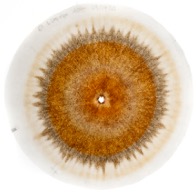
Patterns that are desirable are evenly radiating shapes, mesh-like patterns, and tunnel-like plumes that irradiate from the center to the periphery. The plumes are an important part of the patterns, and we pay attention to how they irradiate, how visible they are, and very importantly how they terminate towards the limit of zone 3 and within zone 4. The terminations that are desirable are almost like narrow teeth, with the plumes reaching all the way to the periphery. At the tips, a volcano-like figure, a triangle with a diffused inverted triangle over it, almost like a volcano with an eruption cloud above it, is a very good sign for zone 4.
As for transitions, the most subtle and gradual change between zones makes for the most desirable pattern. A drastic borderline across zones or a clear distinction of colors or shapes is not desirable. That is why plumes are a key element. The more visible they are, the more they allow for a subtle transition across zones. This continuity shows that all the elements in the soil are integrated and related to each other, minerals being transformed by microorganisms in the organic matter into enzymatic and metabolic components, so to speak. There can be a very rich mineral layer, but if there is no microbiome to chelate and transform the mineral holdings of a soil, the minerals will stay “trapped” in forms that are unusable by the living organisms (plants, fungi, and other microorganisms).
On the interpretation and value of soil chromatography
It is important to insist on the aesthetic nature of the interpretation of chromas. It is very different from a quantitative soil analysis where the analysis brings out numbers and percentages of soil components. For instance, in a quantitative soil analysis, from the physical perspective we receive the classic classification of soils by their percentage of sand, clay, or loam, basically an analysis of the size of particles. We obtain a percentage amount of organic matter and a numbering of elements identified in their detectable molecules. For instance, N is detected commonly as NO. or NH. and P as PO.. These analyses emphasize the main macroelements (NPK) and a few microelements, depending on the type of crop being analyzed and how much you are willing to pay. In the case of pastures, for instance, these studies pay attention to S, Mg, Ca and sometimes, if you are willing to pay even more, Mn, Fe, Zn, and B.
The nature of how you define a problem, or a question, determines implicitly how the solution will be presented. In this case, if a deficiency in a particular element is identified, then the solution is straightforward: add such element to an available (soluble) source to cover such deficiency. As Francisco Abad mentions, agronomists go through years of training to be able to do a cross-multiplication operation so that they can provide a scientific solution to tell farmers how much fertilizer to buy. Noteworthy, but an unnecessary explanation to the keen observer, is that these quantitative soil analyses are presented in such a way that the solutions or actions derived from such analyses come in a packaged form based on the available commercial formulas of soluble fertilizers; the industry presents a diagnosable problem that can be easily fixed by the products they sell.
The weakness of such analysis is that it is a quantitative detection of individual elements, and the interpretation required to understand how they relate to each other within the living soil structure is up to the agronomist. Whoever reads the results decides based on the referential amounts if the soil is deficient or has an excess of a particular element. How the referential amounts are determined is yet another conversation that few pay attention to. Little or nothing is presented in such analysis as to how these elements relate to one another. As we have seen in the discussion of a healthy soil physiology, elements don’t act individually. How one element works impacts how another element works within soil microbiology or plants. Another observation that quantitative soil analysis disregards is that soil is not a sum of individual elements in their chemically detectable forms. These elements are part of a physiology of life that involves the wide diversity of microbiology that moves and transforms elements into the compounds that plants take in for their own processes.
What chromatography offers is a glimpse into the relations of soil processes at the time of their sample. How does microbiology within organic matter interact with mineral reserves in the soil; what is the diversity of mineral components that are available to both plants and microorganisms; how is the physical composition of the soil affecting the water and air holding capacities of the soil, also known as soil structure; and how are the enzymatic and proteic processes occurring at a molecular level across soil life?
Such particularities of the living soil’s dynamics evidence the futility of making any definite conclusions of the results of a singular chroma for two main reasons. The first one is because there is no such thing as a “reference” chroma. Some chromas may be more desirable for a particular crop or region, but there is no perfect chroma out there to compare to. We can use, for instance, the chroma of the “undisturbed” Amazonian soil or perhaps some of the soils we have taken from healthy Andean forests. If there is a referential chroma at all, we would point to a chroma of a healthy forest soil, but even that is specific to its region, latitude, climate, and a huge etcetera that makes it irreplaceable anywhere else. Although the same can be said for quantitative soil analysis, a soil sample taken on a particular day will never be the same as the same soil sampled on a different day. Issues such as climate characteristics, humidity, temperature, wind, and countless factors that are part of an open system such as a plot of soil need to be accounted for, or at the very least acknowledged.
We have witnessed that even the same soil sample processed in two different flasks by the same person using the same standard process produces different chromas. Chromatographers emphasize the energetic or biodynamic aspect of the process by stressing the fact that even the way two people sample the soil and mix the samples produces different chromas, since the energies instilled into the dilutions are not the same. This is something that has been hard to grasp for a scientific mind such as our own, and even harder to try to explain. Let us use a visual example. The following pair of chromas (Fig. 7) are the same sample, the same dilution from the same container, and impregnated at the same time. In short, everything has been the same except that they were revealed onto two different papers. And they are not the same. If you compare them to other chromas from other samples, you can tell that these two are similar enough for us to tell that they come from the same sample, but they are not identical. One shows some patterns or colors more clearly than the other, but their general appearance is similar.
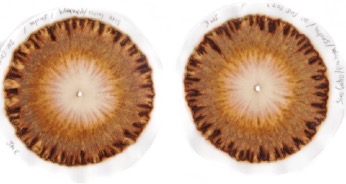
This realization has convinced us of the importance of always running at least two chromas of every sample dilution. Sometimes we will choose one over the other since it shows the characteristics we observe more clearly. We believe, understanding the interpretative and incomplete nature of this analysis, that this fact of having always unique chromas does not reduce or diminish the utility or the relevance of such analysis. Instead, it adds a texturized interpretation of the analyzed soil that matches the philosophical basis of our method: a situated and knowingly incomplete description of material reality that does not attempt to provide a totalizing truth from an open system that has more unknown than known factors. It is easy to understand why Jairo Restrepo aligns chromatography analysis with a type of soil poetry, an art. We intend to take his challenge seriously.
The second reason as to why it is futile to make any definite conclusions from a single chroma is its temporal nature. The analysis is transversal in space and time; it provides us with a point in time and space of the soil we are sampling, and therefore a single point in this spectrum is only something closer to a form of pure plastic artform, not something we can use for getting to know our soils and our interventions on the soil. The usefulness of soil chromatography lies in the creation of a temporal analysis of a series of chromas across different seasons and moments. In the case of pastures, we think the ideal method would be to take an analysis of the soil just before or right after animals come to graze (harvest time) and to do this for every cycle of grazing. For example, our two main sampling sites have two different grazing cycles: in La María, the cycle is close to 30 days; in Los Alpes, it ranges from 60 to 90 days. The practicality and cost of this frequency makes it hard to achieve, so we have aimed for at least two samples per year: one during the wet season (a.k.a. winter) and one during the dry season (a.k.a. summer). Perhaps it would be more desirable to take four samples a year since, even though we are in an equatorial two-seasons region, the planetary and cosmic energies of the four seasons are still in play even if they are subtle enough to be hard to perceive.
Additionally, we have been focusing on taking samples from two kinds of plots. The first ones are plots that have good characteristics and provide us with a reference to what we consider a desirable plot, something measurable qualitatively by the look and feel of the grassland but also quantitatively by the amount of milk that is produced when the herd grazes from such pastures. The second ones are the problematic or troublesome plots, those with undesirable characteristics of the grasslands, delayed or strange growth, and lower milk production. It is on these types of plots that we also carry out quantitative soil analysis, and in the process of reading both types of analysis we devise interventions and strategies to make improvements. Chromatography here brings out its main usefulness: to evidence change across time and, especially, after particular interventions.
A few observations on three chromas
Taken the same day, but with a difference in the stages of pasture. All of them within 15 days of being grazed. All of them have no-till pasture management, grazed using the Voisin method for rational-rotational grazing, fertilized using manure and grass composts, bokashi composts, and mineralized fermented manure liquid fertilizers. Soluble fertilization no more than once per year, and no use of herbicides or agrotoxins of any kind for over 20 years. The samples are named based on the names of the pastures in La María: San Martín (Fig. 8), La Esperanza (Fig. 9), and Santa Inés (Fig. 10).
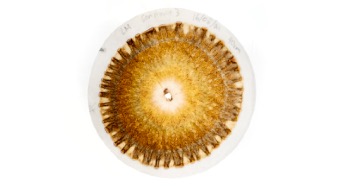
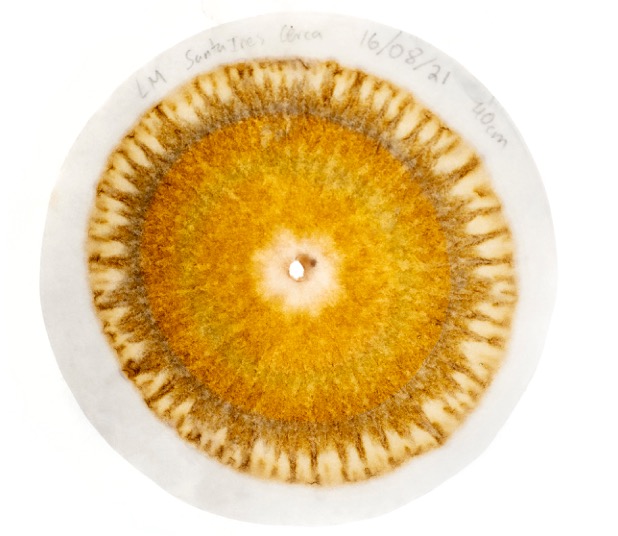
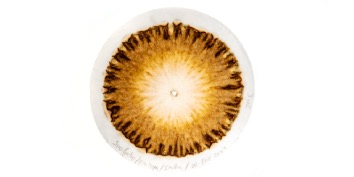
All have a good central zone, light beige in color, San Martín being the larger one and Santa Inés being the smaller one. Integration into zone 1 is better in Martín, going from brown/pink into a dark gold where plumes have begun to show. Zone 1 in Martín is homogenous in color with a perfect transition to a thin greenish to blueish color. Inés and Esperanza central zones change to a very thin dark gold with later changes into lighter gold. Zone 1 in both Inés and Esperanza has these two golden tonalities and not many visible plumes. Zone 1 in both seems larger than in Martín and then transitions into an even thinner greenish layer. Plumes here are visible in Esperanza and a bit less in Inés. Zone 2 transitions similarly in all; the green layer changes to a very subtle, light blueish into a brown rusty-colored layer beginning zone 2. In all three chromas, zone 2 begins close to the 4 cm mark. Plumes here are visible to all, with good shape and spear-like feathers crossing zones 2 and 3 all the way to the limit. Then a darker gray-blue layer changes color immediately but without plume dissipation. This layer is thinner in Martín and thicker in Inés, and in all it fades into darker brown that plumes into the exterior zone. Fading here is clearer in Inés and almost imperceptible in Martín. The exterior layer has a light creamy yellow coloring, finishing with dark brown plumes integrated into zone 2 plumes, clearer teeth-like spaces on Martín and thinner on Esperanza. Orange, rusty water droplets on the terminations are visible in all, larger and more prominent on Martín, similar on the other two.
Mainly due to the subtle and more harmonic integration of the central zone into the intensely visible colors of zones 1 and 2, Martín is the most attractive chroma of the three. The exterior zone is also more complex and vivid with well-defined droplets at the tips of the plumes. In general, all three of them confirm the pattern visible in the soil of La María. A well-set combination of healthy organic matter with a richness in mineral diversity, visible in the richness of the colors in zones 1 and 2, the plumes are subtle but clear. The main weakness lies in the enzymatic integration of the mineral layer and MO activity to work the organic matter in the creation of a more stable structure and water-holding capacity visible in the central zone.
The beach chroma
A sample was taken from the beach within the city of Bahía de Caráquez, a few meters below the edge of high tide sand (Fig. 11).
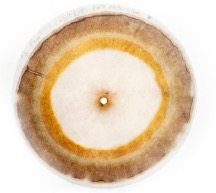
Figure 11. Urban beach sand. Bahía de Caráquez, Manabí.
This chroma shows a huge central zone, all the way to the 4 cm mark. Its center is darker, rusty, and immediately fades into a light creamy white and homogeneous color, drastically shifting to a thin rose pinkish layer with regular but uneven ends. No plumes are visible at all in the chroma. This layer may be the only zone 1 layer, or it may be altogether absent and part of a large zone 2. It’s hard to tell. This layer is thin and covered by a perfectly even thin line of gray and yellow marking followed by a thick layer of light purple that expands to the exterior, with some fading of colors from yellow to gray but no fading of the border. The exterior layer is touching a visible watery zone of a dark orange color. Usually called droplets at the end of plumes, here they are more like ponds in the absence of plumes or teeth-like structures. No zone 3 is visible except for these ponds laying right next to the wide purple layer.
The central zone is as expected, large humidity and water holding, but porous and sandy, with an absence of organic matter, and almost no visible presence of MO activity to be able to integrate or transform the mineral layer. This seems to be the main layer of this kind of soil, and the homogeneity shows that it may be less diverse in mineral content. Mainly silicon, we speculate. Surprisingly, there is evidence of metabolic activity as shown in the periphery. In this case, it may be that life is taking place mainly “above” the soil rather than “below” it, above as in all around it, and not within it. So much we don’t know about the ocean.
An aesthetic reading of an aesthetic object
Up to this point, the chroma has been described as an aesthetic object because it is an image with colors, shapes, and patterns. The whole purpose of revealing this object is to produce an analysis that might tell us something about the life, health, and general characteristics of a particular soil. Thus, chromatography is ultimately a soil analysis, an aesthetic analysis of the soil. As we reach the limits and end purpose of the chroma, we are now compelled to explore new ways of making this reading.
Describing and interpreting a chroma poses a problem or series of questions we have not yet tackled. Since the chroma is an image of a very complex object, the soil, whose ontology—mostly based on networks, families, and sets—impedes any simplification or atomization, it follows that the description and analysis of this image can never be complete. There is certainly a leap between the image and our descriptive analysis, a wound that cannot be smoothened out. At the same time, there is also a leap between the soil and the chroma inasmuch as the chroma attempts to simplify the ontological complexity of the soil by translating it into shapes, colors, and patterns.
These series of leaps are rendered by the ending purpose of chromatography—reading the soil—and thus the whole process is tainted by the ontology of the soil, which impedes simplification. Modifying our view on chromas might give us a new way of approaching not only the method of chromatography itself but also its constitutive agents: the soil, the environment, the campesinos. What if we modify the purpose of the chroma? What if we take it out from the series of methodological steps for soil analysis and consider it as an object in itself that might (or not) render the beginning of another series of steps? What would it mean to consider a chroma separately?
No object can be taken in a complete vacuum, not even an artwork. Every entity pays tribute to a network of objects, a context, and a history[1]. In this sense, the soil chroma pays homage to a (political or emancipatory) technique elaborated throughout decades. It relates to the earth (and its surrounding circumstances) as it is composed of it, and in itself is a network of individual chromas that give rise to the general idea of what a chroma is. The soil chroma can be stripped of its purpose of being an analysis of the soil, but it cannot forget the essential components from which it originated. Without them, the chroma could not be identified; it would be some other thing.
The German philosopher Martin Heidegger is relevant on this point. When speaking about the work of art, he describes it as this special object that has the same role as truth. For Heidegger (2008, p. 182), truth is an unconcealment that, in the context of the work of art, occurs between the earth (the matter) and the world (the network of activities of the living). In its unconcealing nature, truth is not pure illumination, but it is also non-truth because it keeps what is concealed or hidden. The earth, in its utter complexity and ungraspability, is what is hidden, and it is brought to light by the truth. Inasmuch as the earth is material, truth needs to occur in a concrete place, and the work of art is this place that opens up the possibility for truth (or unconcealment) to settle.
It would seem that a chroma could be this place of truth where the earth is unconcealed and turned into world. A chroma might not be an object in a museum or gallery, but it certainly is an object that is used by the campesinos of the world and that forms part of a culture with its particular practices. The work of art, however, is not there to be used but to be this place of openness. Its “function” is merely to exist, and its existence is dependent on the people who preserve such work. In order to preserve, it is not enough to look at or use an object; it requires a certain knowledge: “Preserving the work means standing within the openness of beings that happens in the work. This ‘standing-within’ of preservation, however, is a knowing. Yet knowing does not consist in mere information and notions about something. He who truly knows beings knows what he wills to do in the midst of them” (Heidegger, 2008, p. 192).
In the context of agriculture, chromas have been considered objects for use with a clear purpose in mind—the analysis of the soil as living—but they could also be considered as this place where unconcealment or creation of a world takes place and thus is worth preserving. “The proper way to preserve the work,” says Heidegger (2008, p. 193), “is co-created and prescribed only and exclusively by the work.” Chromas need to co-dictate, as it were, their means of preservation. The preserver is given immediate access to this knowledge because she also plays the part of being a creator. As the reader might already imagine, the problem of interpretation here vanishes, as there is no longer a gap between the work/chroma and the preserver.
As preservers, we have arranged to make poems that accompany some samples of chromas. As semitexts—dependent on the existence of the chromas—the poems that follow attempt to insert a new mode of knowing the chromas, an intimate, aesthetic, intuitive mode that attempts to take chromas as works of art that might establish worldly relationships beyond those of the analysis of the soil. In expanding the scope of chromas and intimately working with the earth, we further intend to route the problem of the origin towards its closure. Could chromas be the origin of a world?
Completing the chromas
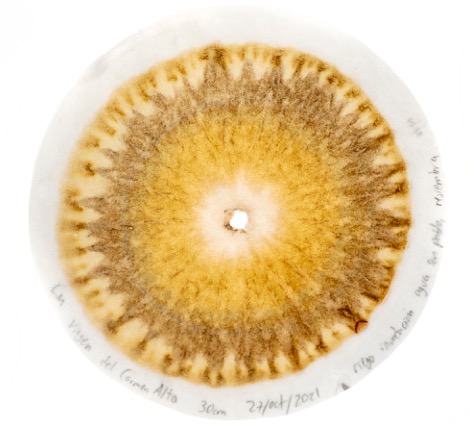
a manera de carcasa
despliegas ya la nube
te protege
no solo del ambiente
sino de tu contraparte
no te veo tierra
in the form of casing
you deploy the cloud already
it protects you
not only from the environment
but from your counterpart
I do not see you earth
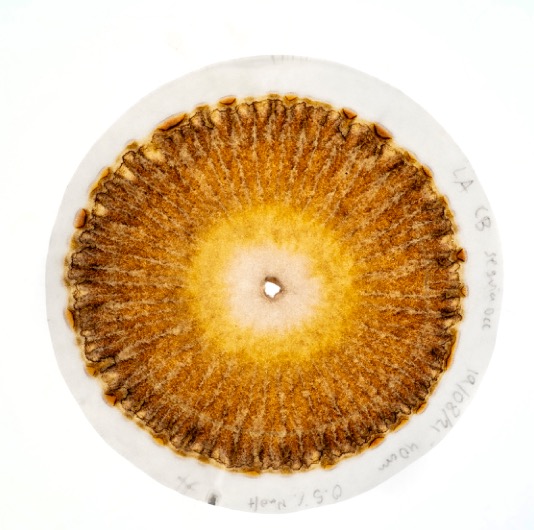
sin analogía ni semblanza
tu granularidad se acerca
estamos dentro tuyo
quemas todo arde
pero al hacerlo un espacio
se convierte en hospedaje
without analogy nor semblance
your granularity approaches
we are inside you
you ignite everything burns
but in doing so a space
becomes a shelter
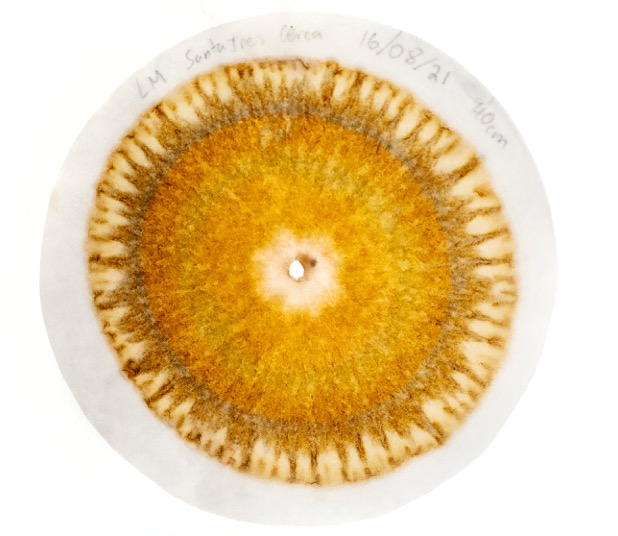
ya desbrozaremos de a poco
la riqueza de tus límites
algún día confiaremos
en la división de partes
por lo pronto no te alejes
déjame que me distraiga
we will gradually clear
the richness of your limits
someday we will trust
in the division of parts
for now don’t move away
allow me to distract myself
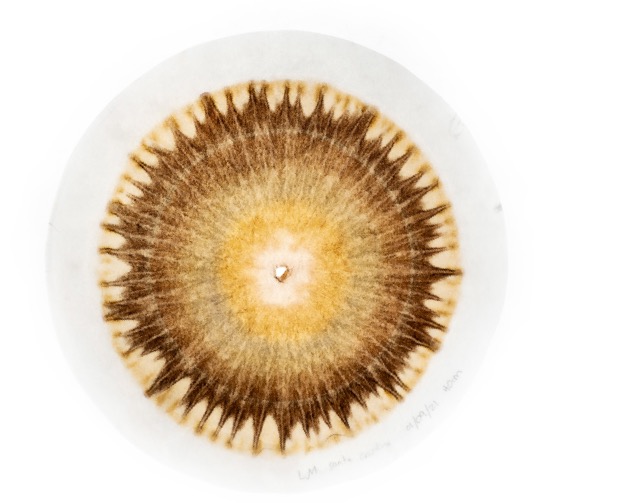
he visto ya tu regla
tu necesidad que ahuyenta
no es de palo sino ácida
por eso cuando te recoges
dejas extendido el brazo
pedazo de regalo
I’ve seen your rule already
your need that drives away
it’s not made out of wood but acid
that’s why when you recoil
you leave your arm outstretched
a great present
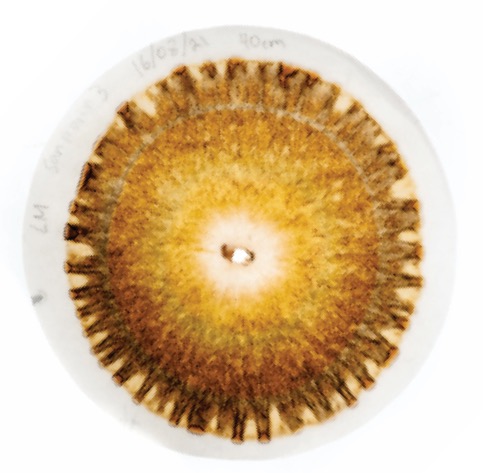
hemos arribado finalmente
a un hábitat desconocido
sus bondades otras
lisas parabólicas
con respecto al planeta
alguna vez llamado tierra
su valoración incierta
finally we have arrived
to an unknown habitat
its other provisions
smooth parabolic
with respect to the planet
once called earth
its uncertain valuation
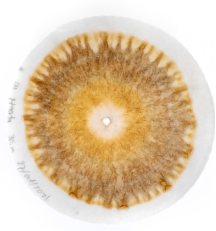
mantenimiento e indiferencia
a paso estable juegas
muy rara vez traicionas
yo solo aspiro a echarme
al solaz del grano
guías sin que me percate
maintenance and indifference
at a steady pace you play
very seldom do you betray
I only aspire to lie down
to the solace of the grain
you guide without me noticing
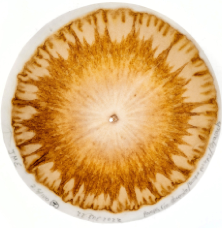
no estamos preparados
para amarte
hace falta que nos arrastremos
pero falta poco
basta que me topen
para regarme en escarpado
we are not prepared
to love you
we have to drag ourselves along
but it won’t take long
it is enough to touch me
for me to water steeply
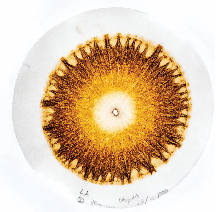
cuando podía ver mis vísceras
¿o era mi esfínter?
tú cobrabas vida
lucha entre comillas
para la cual doblegas
sin encontrar revuelta
tristemente mermas
when I could see my viscera
or was it my sphincter?
you came to life
a fight between quotation marks
for which you bow
without finding rebellion
sadly you diminish
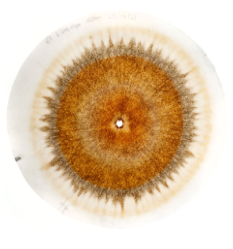
piensas todo el día
aspiras a superponerte
y a pesar de ello niegas
la posibilidad del dualismo
la diferencia llama
pero contigo muto
all day long you think
you aspire to supersede yourself
and in spite of that you deny
the possibility of dualism
the flame difference
but with you I mutate
Works Cited
Barad, K. (2007). Meeting the Universe Halfway. Duke University Press.
Barnett, J. A., Bandy, M. L., & Gibson, D. L. (2022). Is the Use of Glyphosate in Modern Agriculture Resulting in Increased Neuropsychiatric Conditions Through Modulation of the Gut-brain-microbiome Axis? Frontiers in Nutrition, 9. https://www.frontiersin.org/article/10.3389/fnut.2022.827384
Bergson, H. (1944). Creative Evolution (A. Mitchell, Trans.). Random House.
Chan, Y. K., Estaki, M., & Gibson, D. L. (2013). Clinical consequences of diet-induced dysbiosis. Annals of Nutrition & Metabolism, 63 Suppl 2, 28–40. https://doi.org/10.1159/000354902
Davis, D. R. (2009). Declining Fruit and Vegetable Nutrient Composition: What Is the Evidence? HortScience, 44(1), 15–19. https://doi.org/10.21273/HORTSCI.44.1.15
Fan, M. S., Zhao, F. J., Fairweather-Tait, S. J., Poulton, P. R., Dunham, S. J., & McGrath, S. P. (2008). Evidence of decreasing mineral density in wheat grain over the last 160 years. Journal of Trace Elements in Medicine and Biology, 22(4), 315–324. https://doi.org/10.1016/j.jtemb.2008.07.002
Handal, A. J., Harlow, S. D., Breilh, J., & Lozoff, B. (2008). Occupational Exposure to Pesticides During Pregnancy and Neurobehavioral Development of Infants and Toddlers. Epidemiology, 19(6), 851–859. https://doi.org/10.1097/EDE.ObO
Haraway, D. (1988). Situated Knowledges: The Science Question in Feminism and the Privilege of Partial Perspective. Feminist Studies, 14(3), 575–599. https://doi.org/10.2307/3178066
Haraway, D. (2016). Staying with the Trouble: Making Kin in the Chthulucene. Duke University Press.
Harman, G. (2002). Tool-Being: Heidegger and the Metaphysics of Objects. Open Court.
Harman, G. (2018). Object-oriented ontology: A new theory of everything. Penguin.
Heidegger, M. (2008). The origin of the work of art. In D. F. Krell (Ed. & Trans.), Basic writings: From Being and time (1927) to The task of thinking (1964) (pp. 143–212). Harper Perennial Modern Thought.
Kohn, E. (2015). Anthropology of Ontologies. Annual Review of Anthropology, 44(1), 311–327. https://doi.org/10.1146/annurev-anthro-102214-014127
Latour, B. (1993). We have never been modern (C. Porter, Trans.). Harvard University Press.
Meillassoux, Q. (2008). After finitude: An essay on the necessity of contingency (R. Brassier, Trans.). Continuum.
Morton, T. (2013). Poisoned Ground: Art and Philosophy in the Time of Hyperobjects. Symploke, 21(1–2), 37–50. https://doi.org/10.1353/sym.2013.0025
Paz-y-Miño, C., Bustamante, G., Sánchez, M. E., & Leone, P. E. (2002). Cytogenetic monitoring in a population occupationally exposed to pesticides in Ecuador. Environmental Health Perspectives, 110(11), 1077–1080.
Raynaud, X., & Nunan, N. (2014). Spatial Ecology of Bacteria at the Microscale in Soil. PLoS ONE, 9(1), e87217. https://doi.org/10.1371/journal.pone.0087217
Restrepo, J., & Pinheiro, S. (2015). Cromatografía.
Suarez-Lopez, J. R., Jacobs, D. R., Himes, J. H., & Alexander, B. H. (2013). Acetylcholinesterase activity, cohabitation with floricultural workers, and blood pressure in Ecuadorian children. Environmental Health Perspectives, 121(5), 619–624. https://doi.org/10.1289/ehp.1205431
Suarez-Lopez, J. R., Jacobs, D. R., Himes, J. H., Alexander, B. H., Lazovich, D., & Gunnar, M. (2012). Lower acetylcholinesterase activity among children living with flower plantation workers. Environmental Research, 114, 53–59. https://doi.org/10.1016/j.envres.2012.01.007
Notes